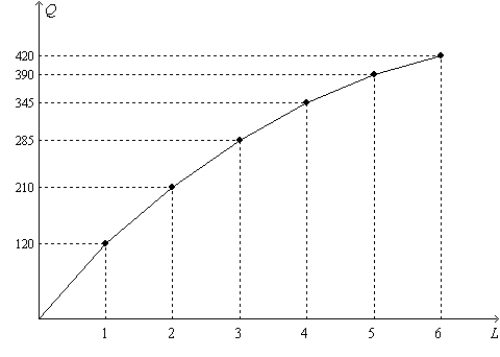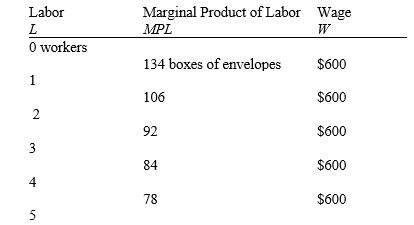A) both equilibrium wages and equilibrium employment to increase.
B) both equilibrium wages and equilibrium employment to decrease.
C) equilibrium wages to increase and equilibrium employment to decrease.
D) equilibrium wages to decrease and equilibrium employment to increase.
Correct Answer

verified
Correct Answer
verified
Multiple Choice
Suppose that a rare virus infects and kills a significant percentage of the population. Assuming that land and labor are complements in a farming production function, what would happen to the wages earned by workers and the rents earned by landowners?
A) Both wages and rents would increase.
B) Both wages and rents would decrease.
C) Wages would increase, and rents would decrease.
D) Wages would decrease, and rents would increase.
Correct Answer

verified
Correct Answer
verified
Multiple Choice
Table 18-5  -Refer to Table 18-5. The price of output is
-Refer to Table 18-5. The price of output is
A) $1.
B) $2.
C) $3.
D) $4.
Correct Answer

verified
Correct Answer
verified
Multiple Choice
Suppose that the market for labor is initially in equilibrium. Suppose that workers' tastes change so that they choose to retire at age 55 rather than age 67. Then the equilibrium wage
A) and the equilibrium quantity of labor will rise.
B) and the equilibrium quantity of labor will fall.
C) will rise, and the equilibrium quantity of labor will fall.
D) will fall, and the equilibrium quantity of labor will rise.
Correct Answer

verified
Correct Answer
verified
Multiple Choice
Which of the following is correct?
A) Any event that changes the supply or demand for labor must change the value of the marginal product.
B) A profit-maximizing firm hires workers so long as the wage rate exceeds the value of the marginal product of labor.
C) An increase in the supply of labor increases both employment and wages.
D) A decrease in the demand for labor decreases wages but increases employment.
Correct Answer

verified
Correct Answer
verified
Multiple Choice
Consider the labor market for computer programmers. During the late 1990s, the value of the marginal product of all computer programmers increased dramatically. Holding all else equal, the equilibrium quantity in the labor market for computer programmers
A) increased.
B) decreased.
C) did not change.
D) It is not possible to determine the equilibrium quantity.
Correct Answer

verified
Correct Answer
verified
True/False
The idea that rational employers think at the margin is central to understanding how many units of labor they choose to employ.
Correct Answer

verified
Correct Answer
verified
Multiple Choice
If the wages of a CPA decrease, (i) her opportunity cost of leisure increases. (ii) her opportunity cost of leisure decreases. (iii) her hours of labor supply may increase. (iv) her hours of labor supply may decrease.
A) (i) and (iii) only
B) (ii) and (iv) only
C) (i) , (iii) , and (iv) only
D) (ii) , (iii) , and (iv) only
Correct Answer

verified
Correct Answer
verified
True/False
For profit-maximizing, competitive firms, the demand curve for each factor of production equals the value of the marginal product of that factor.
Correct Answer

verified
Correct Answer
verified
Multiple Choice
Harold owns a cranberry bog in which he grows cranberries. Harold's farm is a competitive, profit-maximizing firm. As such, Harold much decide (i) how many cranberries to sell. (ii) what price to charge for his cranberries. (iii) what wages to pay his workers. (iv) how many workers to hire.
A) (i) only
B) (ii) and (iii) only
C) (i) and (iv) only
D) (i) , (ii) , (iii) , and (iv)
Correct Answer

verified
Correct Answer
verified
Multiple Choice
For a profit-maximizing, competitive firm, the value of the marginal product of labor
A) increases when the price of output decreases.
B) is the firm's demand for labor.
C) equals the marginal product of labor divided by the wage rate.
D) All of the above are correct.
Correct Answer

verified
Correct Answer
verified
Multiple Choice
Scenario 18-5 Suppose that workers from northern Minnesota, North Dakota, and Montana decide to emigrate to southern Canada. -Refer to Scenario 18-5. In the labor market in southern Canada, the equilibrium wage
A) and the equilibrium quantity of labor will rise.
B) and the equilibrium quantity of labor will fall.
C) will rise, and the equilibrium quantity of labor will fall.
D) will fall, and the equilibrium quantity of labor will rise.
Correct Answer

verified
Correct Answer
verified
Multiple Choice
Table 18-B
Consider the following daily production data for MadeFromScratch, Inc. MadeFromScratch sells cupcakes for $3 each and pays the workers a wage of $325 per day.  -Refer to Table 18-B. What is the third worker's marginal product of labor?
-Refer to Table 18-B. What is the third worker's marginal product of labor?
A) 125 cupcakes
B) 150 cupcakes
C) 200 cupcakes
D) 475 cupcakes
Correct Answer

verified
Correct Answer
verified
Multiple Choice
Table 18-7  -Refer to Table 18-7. What is the value of the cell labeled GG?
-Refer to Table 18-7. What is the value of the cell labeled GG?
A) $400
B) $100
C) $0
D) −$100
Correct Answer

verified
Correct Answer
verified
Multiple Choice
Figure 18-1
On the graph, L represents the quantity of labor and Q represents the quantity of output per week.  -Refer to Figure 18-1. Suppose the firm sells its output for $12 per unit, and it pays each of its workers $700 per week. How many workers will the firm hire to maximize its profit?
-Refer to Figure 18-1. Suppose the firm sells its output for $12 per unit, and it pays each of its workers $700 per week. How many workers will the firm hire to maximize its profit?
A) 2
B) 3
C) 4
D) 5
Correct Answer

verified
Correct Answer
verified
Multiple Choice
Table 18-12
The table displays data for a small, competitive, profit-maximizing firm that produces and sells envelopes. The time frame is one week.  -Refer to Table 18-12. Suppose the firm sells each box of envelopes that it produces for $6. What is the value of the marginal product of the second worker?
-Refer to Table 18-12. Suppose the firm sells each box of envelopes that it produces for $6. What is the value of the marginal product of the second worker?
A) $1,440
B) $1,212
C) $636
D) $552
Correct Answer

verified
Correct Answer
verified
Multiple Choice
The marginal product of labor is the
A) marginal revenue product minus the wage paid to the worker.
B) total amount of output divided by the total units of labor.
C) increase in the amount of output from an additional unit of labor.
D) None of the above is correct.
Correct Answer

verified
Correct Answer
verified
Multiple Choice
Suppose that the labor market for life guards is initially in equilibrium. Then a new television series debuts which glamorizes the social opportunities for life guards. What happens to the equilibrium wage and quantity of life guards?
A) Both the equilibrium wage and quantity increase.
B) Both the equilibrium wage and quantity decrease.
C) The equilibrium wage increases, and the equilibrium quantity decreases.
D) The equilibrium wage decreases, and the equilibrium quantity increases.
Correct Answer

verified
Correct Answer
verified
Multiple Choice
If the value of the marginal product of labor exceeds the wage, then hiring another worker increases the firm's
A) profit.
B) total cost.
C) total revenue.
D) All of the above are correct.
Correct Answer

verified
Correct Answer
verified
Multiple Choice
Table 18-7  -Refer to Table 18-7. What is the value of the cell labeled II?
-Refer to Table 18-7. What is the value of the cell labeled II?
A) -$100
B) $100
C) $200
D) $300
Correct Answer

verified
Correct Answer
verified
Showing 321 - 340 of 592
Related Exams